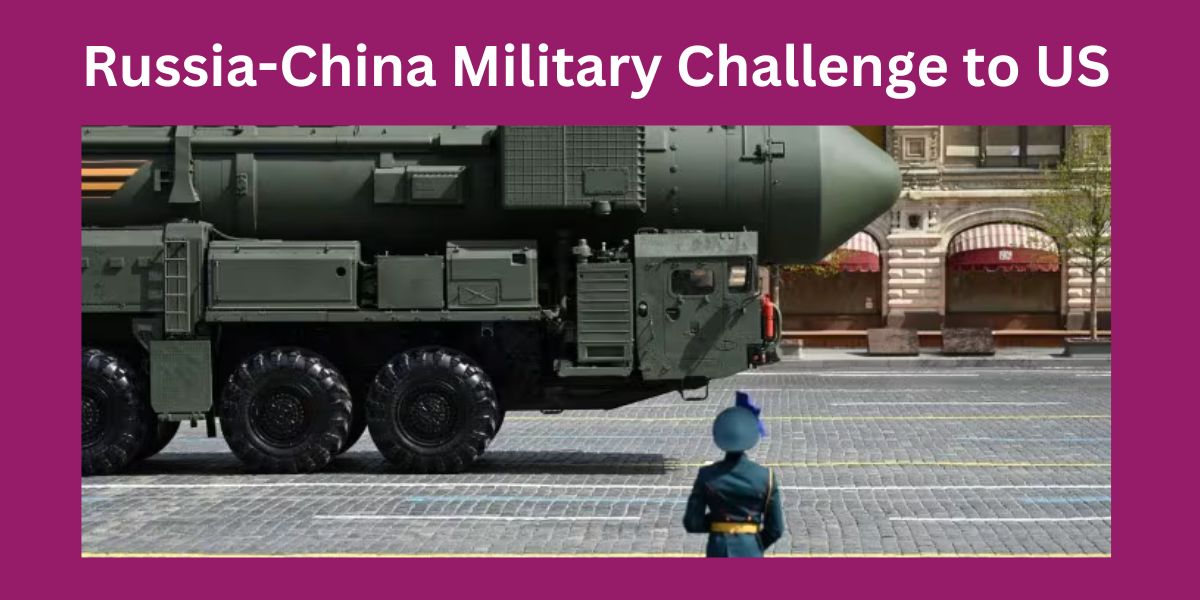The geopolitical tension between the United States, Russia, and China has been heating up in recent years. As these global powers flex their military muscles, it’s clear that the world is watching. So, how is the White House responding to this growing challenge from Russia and China? Let’s dive into the strategies, concerns, and the potential implications for global security.
Understanding the Military Challenge
When we talk about the “Russia-China military challenge,” we’re referring to a growing alliance between these two nations. Both countries have ramped up their military exercises, arms development, and cooperation in ways that suggest they’re preparing to counterbalance the United States. It’s not just saber-rattling anymore—it’s a calculated push to challenge America’s global military dominance.
A Growing Alliance: Russia and China Teaming Up
Historically, Russia and China haven’t always been the best of friends. However, the tides have turned in recent years. Now, they’re working closely together, particularly in areas like military drills, intelligence sharing, and arms trading. This cooperation has raised eyebrows in Washington, making it clear that the U.S. has more than just one rival to worry about.
Joint Military Exercises
Both nations have been conducting joint military exercises, showcasing their ability to collaborate in land, sea, and air warfare. These drills, often held near the borders of key U.S. allies, signal that Russia and China are not afraid to flaunt their growing military strength. The U.S. sees these drills as a message: Russia and China are ready to push back against American influence, particularly in Eastern Europe and the Asia-Pacific region.
Advanced Weaponry and Technology
In addition to joint exercises, both nations are advancing their military technology. Hypersonic missiles, stealth fighters, and advanced naval vessels are just some of the developments coming out of Russia and China’s military-industrial complexes. The U.S., while confident in its own technological superiority, knows that it can’t afford to rest on its laurels.
The White House’s Response to the Growing Threat
So, how is the White House handling this rising military threat from two of its biggest global rivals? The answer is a mix of diplomacy, military strategy, and economic pressure.
Diplomatic Efforts: Strengthening Alliances
One of the key strategies has been strengthening the U.S.’s alliances across the globe. By reinforcing ties with NATO, Australia, Japan, and South Korea, the U.S. is ensuring that it has strong allies to counterbalance Russia and China. The White House understands that it can’t go it alone. Having reliable partners in strategic regions is essential to curbing any potential aggression.
Revamping Military Strategies
On the military front, the U.S. is modernizing its forces to meet the new challenges posed by Russia and China. The White House has made clear that while it seeks peace, it will not hesitate to defend its interests and those of its allies. This includes increasing military budgets, updating weaponry, and expanding U.S. military presence in key regions like Eastern Europe and the South China Sea.
Economic Sanctions: A Non-Military Tool
Sanctions remain one of the White House’s favorite tools. By imposing economic restrictions on Russia and China, the U.S. hopes to weaken their military ambitions without resorting to direct conflict. However, both Russia and China have found ways to minimize the impact of these sanctions, making it a challenging game of cat and mouse.
The Role of NATO and Allies in Countering the Threat
The U.S. isn’t facing this challenge alone. NATO and other allies play a crucial role in countering the military threat posed by Russia and China.
NATO’s Collective Defense
NATO’s principle of collective defense means that if Russia were to attack one member nation, all NATO members would respond in kind. This principle acts as a strong deterrent, especially in Eastern Europe, where Russia has been expanding its military presence. The White House, under multiple administrations, has stressed the importance of NATO in maintaining global peace and security.
Partnerships in the Asia-Pacific
In the Asia-Pacific region, the U.S. has been working closely with countries like Japan, South Korea, and Australia. These nations are on the front lines of any potential military conflict with China. By strengthening these alliances, the U.S. ensures that it has regional partners who can help counter China’s growing influence.
The South China Sea: A Flashpoint for Tensions
One of the most significant areas of tension between the U.S. and China is the South China Sea. China’s territorial claims in this region have been a point of contention for years, and its militarization of islands has only exacerbated the issue.
Freedom of Navigation Operations
In response, the U.S. regularly conducts Freedom of Navigation Operations (FONOPs) in the South China Sea. These operations are meant to assert that international waters remain open to all nations, countering China’s claims of sovereignty over the region. While these operations have led to some tense stand-offs, they’re a critical part of the U.S.’s strategy to push back against Chinese expansion.
The Role of ASEAN Countries
The U.S. has also been working with ASEAN (Association of Southeast Asian Nations) to counter China’s influence in the region. Countries like the Philippines and Vietnam, which have their own territorial disputes with China, are key players in this effort. By partnering with these nations, the U.S. hopes to present a united front against Chinese aggression in the South China Sea.
Cyber Warfare: The New Battleground
In the 21st century, military power isn’t just about tanks and fighter jets. Cyber warfare has become a critical component of modern military strategy, and both Russia and China have proven themselves to be formidable players in this arena.
Russia’s Cyber Attacks
Russia has been accused of using cyber warfare to undermine its adversaries, including the U.S. From hacking political campaigns to targeting infrastructure, Russia’s cyber capabilities are a major concern for the White House. The U.S. has responded with its own cyber defense initiatives, but the battle is far from over.
China’s Espionage Efforts
China, on the other hand, has been more focused on cyber espionage. Stealing intellectual property, infiltrating government systems, and hacking corporations are all part of China’s strategy to gain a competitive edge over the U.S. The White House is fully aware of these threats and has been ramping up its efforts to protect against them.
What’s Next? The Future of U.S. Military Strategy
Looking ahead, it’s clear that the U.S. faces a significant challenge in countering the growing military power of Russia and China. But the White House is not backing down.
Continued Investment in Defense
The U.S. will continue to invest heavily in its military, ensuring that it stays ahead of the curve in terms of technology and capability. Hypersonic missiles, AI-driven warfare, and advanced cyber defenses are just a few areas where the U.S. is looking to maintain its edge.
Diplomatic Efforts Will Continue
While military power is important, the White House knows that diplomacy is equally critical. The U.S. will continue to work with its allies to present a united front against Russian and Chinese aggression, using every tool at its disposal—from sanctions to trade deals—to keep the peace.
Conclusion: A Delicate Balancing Act
In the end, the White House faces a delicate balancing act. The military challenge from Russia and China is real, but the U.S. remains committed to maintaining global peace and security. With a combination of military strength, diplomatic efforts, and strategic alliances, the U.S. is prepared to face whatever comes next.
FAQs
1. What are Russia and China hoping to achieve by teaming up?
Russia and China aim to counterbalance U.S. influence globally. Their partnership strengthens their military and political influence, challenging America’s dominance.
2. How is the U.S. responding to the military challenge?
The U.S. is strengthening alliances, modernizing its military, increasing economic sanctions, and conducting diplomatic efforts to counter the growing threat.
3. What role does NATO play in this situation?
NATO’s principle of collective defense ensures that if Russia attacks any member nation, all members will respond, making it a strong deterrent against aggression.
4. Is cyber warfare a significant concern?
Yes, both Russia and China have advanced cyber warfare capabilities. The U.S. has been increasing its cyber defenses to counter these threats.
5. Will there be direct conflict between the U.S., Russia, and China?
While tensions are high, all nations are likely to avoid direct conflict due to the potentially catastrophic consequences. Diplomatic efforts are ongoing to maintain peace.










